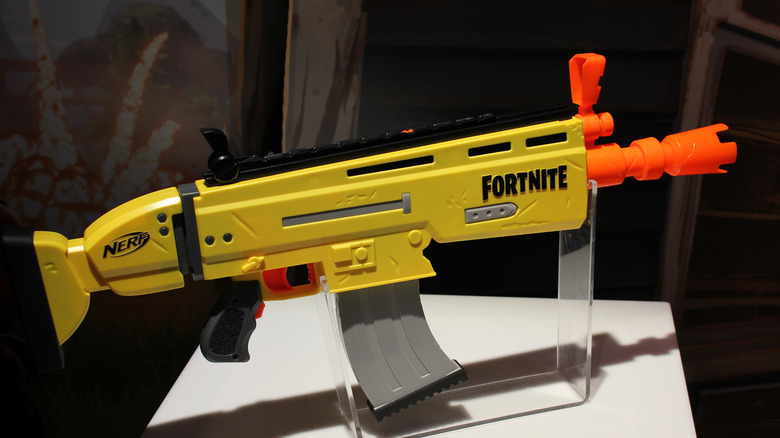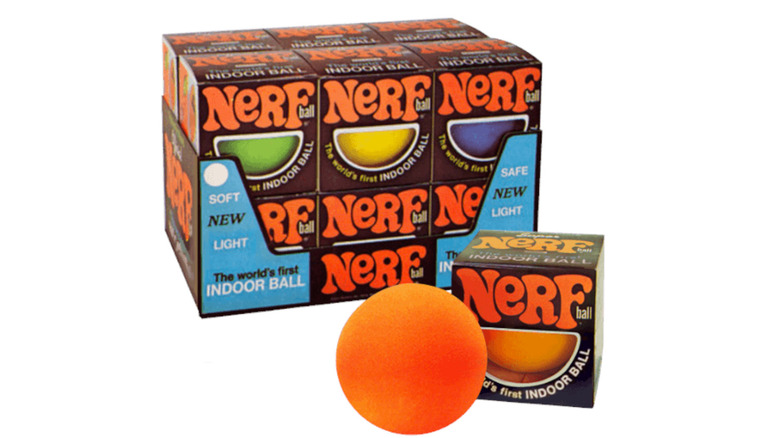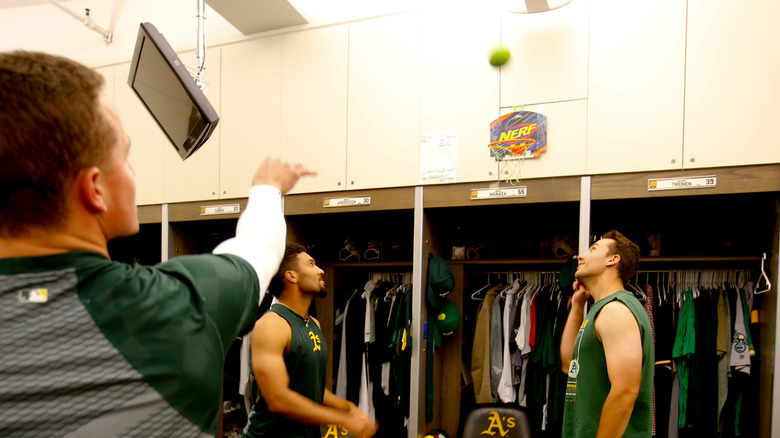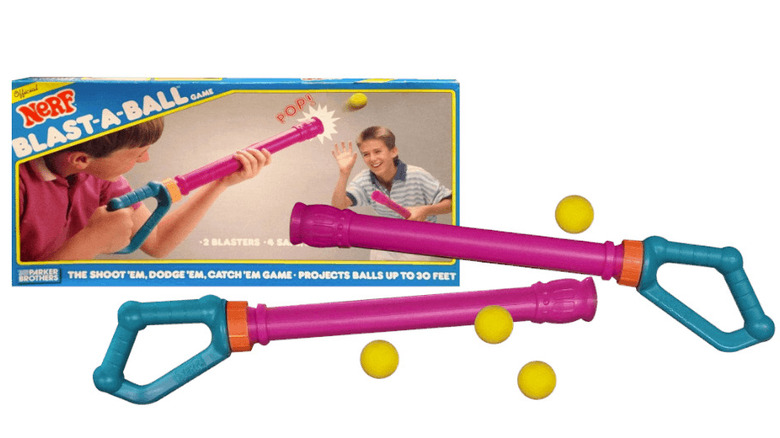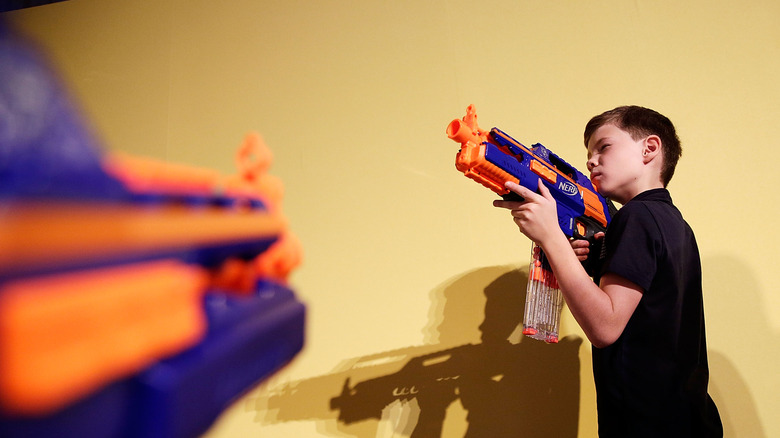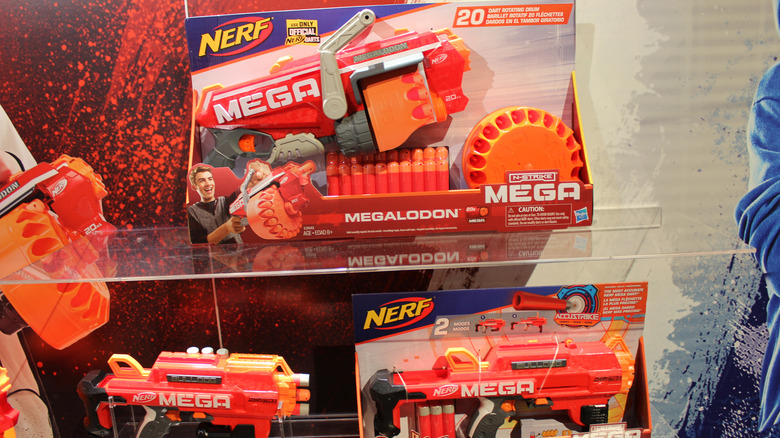What Happened To Nerf Blaster?
There are few childhood memories as great as gathering a bunch of friends, an armory of Nerf blasters, and dozens of Nerf darts — half of which will inevitably go missing — and starting an all-out, no-holds-barred Nerf War. Perhaps the perfect form of non-lethal childhood combat, Nerf battles are more tactile than laser tag, but not as painfully welt-inducing as paintball.
Good old-fashioned Nerf wars produce nothing but good times and laughter, with the occasional burst of tears when a wayward dart accidentally hits your younger sibling in the eye. While it may feel like they've been around forever, Nerf blasters weren't introduced until the 1990s, and that was only after decades' worth of recreational innovations, advancements in Nerf technology, and even the introduction of other forms of childhood weaponry which were predecessors of the beloved dart-firing Nerf Blasters. One particular water-firing predecessor had massive success on its own before it eventually became a part of the Nerf family of products (via Hasbro).
The dawn of Nerf
According to Britannica, the Bronze Age started and ended thousands of years ago, but the dawn of the Nerf Age is far more recent.
The idea came from inventor Reyn Guyer. According to Mental Floss, Guyer was also responsible for another childhood favorite game, Twister. He and his team were developing a new game that was based on cavemen and used fake rocks made of foam. One of the team members started bouncing one of the foam rocks and their focus shifted to developing games using the foam balls. The first Nerf Ball was turned down by several companie,s so it was released independently, and the first version was a four-inch ball made of polyurethane.
The Nerf Ball hit the market in 1969 and turned out to be a safe way for kids to play ball in the house without shattering windows, breaking lamps, or destroying priceless family heirlooms. According to Hasbro, the original marketing campaign even said, "Throw it indoors; you can't damage lamps or break windows. You can't hurt babies or old people."
There must have been an untapped market of people looking for baby and old people-proof foam balls, because millions of Nerf Balls were sold by the end of 1969. This was just the start for Nerf, which would go on to take over the world ... of indoor recreation, anyway.
Nerf innovation continues
While the Nerf Ball alone was a good start, more development was on the horizon that would transform what was once thought possible with a foam ball. Bouncing a ball around the house is cool, but how about if it could be used for a makeshift slam dunk contest? That's what the Nerf basketball hoop could do. According to Hasbro, it was branded as the NERFoop, upon its release in 1972. Up to that point, dunking a basketball had been a feat reserved for only the truly athletically gifted. Nerf opened the proverbial door from which the NERFoop was hung to wanna-be ballers everywhere, allowing anyone the chance to throw down a windmill dunk and accidentally put an errant knee through their bedroom door.
That was just the start of Nerf's domination of the sports landscape. That same year Nerf footballs made their debut. Previous incarnations of Nerf Balls were manufactured by cutting down a piece of foam on a spinning lathe (via Mental Floss). A football's oblong shape made this method impossible, so Nerf footballs were instead produced by pouring foam into molds. Just over 10 years later, Nerf took a swing at another sport, this time introducing the Nerf Baseball in 1983.
Nerf Blaster precursors
The end of the '80s saw further progress toward Nerf Blasters as toys that are clear ancestors began to emerge. In 1989, a then-un-Nerf-related toy found some major success in the toy industry. According to Hasbro, it was a water gun that used pressurized air to shoot water greater distances than any similar toy ever had before. It was originally called the Power Drencher, a name that may not ring a bell, but that's because it was eventually changed to the certainly more familiar name, the Super Soaker. The Super Soaker was massively successful and became a Nerf product in 2010.
The same year the Super Soaker made its debut, Nerf introduced their first projectile launching toy. The Nerf Blast-a-Ball — which is both its name and a description of what it did — was a tube with a plunger that when pushed shot small Nerf balls up to 40 feet (via Nerfz). The Nerf Blast-a-Ball was sold in packs of two, which encouraged a competitive aspect to playing with them.
Hasbro acquired the Nerf brand in 1991. It was almost time for the birth of the Nerf Blaster, but first, and perhaps following the historical trajectory of weapons development, a Nerf bow and arrow was released that same year.
The Nerf Blaster finally debuts
After nearly 25 years of Nerf research and development, the first Nerf Blaster — the Nerf Sharpshooter — was introduced (via Hasbro). It was a relatively small toy that shot darts with suction cups on the end of them. According to Nerfz, it was around this time that Hasbro introduced the slogan "It's Nerf or Nothin'!" which was extremely successful and helped drive sales.
More Nerf Blasters were unveiled throughout the 1990s, with some that shot different types of projectiles, like the Blast-a-Ball style mini-Nerf balls, in addition to regular foam darts and suction-cupped foam darts. Nerf Blasters became a huge success and their appeal was massive. Kids liked how they could have full-fledged battles with their friends, while parents felt comfortable buying them because they knew that the risk of property damage or bodily harm was relatively low.
Other features that were introduced in the first few years of Nerf Blasters included models with rotating dart chambers and even a 1998 model called Hyper Sight Expand-a-Blast which had an extendable stock and barrel. In the years to come, the Nerf brand would continue to do the only thing it knows how to do: push boundaries of what foam weaponry can accomplish.
Nerf Blasters today
Nerf Blasters are still alive and well today, and with each new incarnation, the technological leaps in Nerf warfare have been staggering.
According to Hasbro, 2004 saw the release of the Nerf N-Strike Blaster, which had a modular design that was essentially three blasters in one and could even shoot a large Nerf rocket. Next up was the Nerf Vulcan, which the Hasbro website describes as "one of the biggest and baddest blasters to date." Remember painstakingly loading a Nerf Blaster by hand, dart by dart? Well, the Vulcan was belt-fed like a machine gun, allowing the person pulling the trigger to unleash an unholy Nerf spray on the opposition. Along those same lines, Nerf has also released models like 2019's Nerf Ultra, which utilized specially designed darts loaded onto a large spinning drum reminiscent of a Thompson submachine gun, which adds a little Prohibition-era gangster flavor to a Nerf battle.
For those who can't be bothered to hold and use a manually-fired Nerf Blaster, Hasbro has even introduced a remote-controlled dart-firing drone. The Nerf N-Strike Elite Terrascout RC was released in 2016 and was the first-ever remote-controlled piece of Nerf weaponry.
